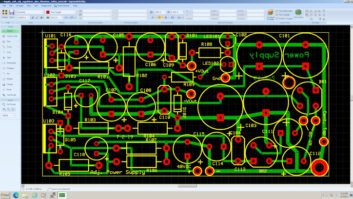A few months ago, engineers visiting Dave Biondi’s radio-tech list serve on broadcast.net discussed self-inflicted problems. Without naming names, a couple of interesting stories were shared.
The first was a Marti STL-10 that was going intermittent. It was a new installation, and the engineer couldn’t understand why the STL-10 was cutting power.
The problem?A very short half-inch piece of 36 gauge wire shorting the drive to the PA. Where did the wire come from? The engineer stripping a stranded shielded pair above the STL-10’s well-ventilated enclosure. A lesson learned a little too well!
. . .
Combating the problem of “lost parts” can be as simple as using a piece of bubble wrap to cover the top cover vents in equipment. In addition to keeping strands of wire from finding their way inside, any screw, nut or washer dropped will get caught in the bubbles and will not bounce or roll.
The pink static-proof kind of bubble wrap also makes circuit boards happy. You can make your life easier by laying this bubble wrap in the bottom of your equipment rack, or even on the floor of your transmitter to “grab” fallen parts.
. . .
(click thumbnail)Fig 1: The Commercial Radio Network in South Africa uses these custom configurable keypads. Any keystroke or combination of strokes can be assigned to a key. Alastair Gray works with the Commercial Radio Network in Midrand, South Africa. He read, with interest, our suggestion for using pre-fab keyboards for custom applications in studios.
CRN has come up with its own elegant solution, seen in Fig. 1.These are custom configurable keypads, so any keystroke or combination of keystrokes can be assigned to a key. The keyboard pads are extremely durable and easy to use. Gray says many of the network’s presenters (jocks) relate to the older technology look – big buttons, easily identified. The clear layout helps a lot.
The network uses the keypads as part of its Radiohost PC system; more information is available at www.radiohost.com. The F-keys are used as hotkeys to fire off regularly used audio clips or sound effects.

. . .
Remember the Boy Scout motto “Be Prepared”? Here are a couple of steps you can take now that will make you a hero later. They are offered by engineering consultant Tom Osenkowsky.
First make sure you have a spare muffin fan for your exciter. A little advance preparation will save you some money. These fans can be purchased from discount electronic suppliers.
While you’re checking part numbers, jot down the part number for the transmitter blower motor. Again, blower motors can be purchased from suppliers like W.W. Grainger at considerable savings.
Early in my career, an engineer showed me how he’d broken the blower wiring and installed male/female Molex-type, three-terminal quick-connect plugs in each of his transmitters. A mating plug was installed on the wiring of the spare blower motor. If a failure occurred, the down time was reduced considerably. By pre-wiring the spare blower, phase/rotation issues also were eliminated.
Remember, screaming bearings won’t heal themselves. Bearings can be replaced at a fraction of a new blower motor. Again, the secret is to plan.
If the blower doesn’t work, try spinning it manually to get it started. The blower motor may be fine; the start-up capacitor may be bad. If the motor spins freely, try replacing the capacitor. It’s an easy part to replace, and again, saves a lot of money over a replacement motor.
Is your transmitter in a dirty environment? Tube-change time is a good time to see how efficient your blower assembly is.
Fan blades or fins clogged with dirt – common in dirty transmitter environments – mean air flow is reduced. There may be enough cooling to keep the air interlock switch closed (check to see that this switch is working, too) but the air volume is reduced, cooking the tube.
As you remove the tube from the socket, look at the underneath. If you see discolored ceramic or contacts, check the tube socket finger stock and the fan volume.
After cleaning a tube socket, and before inserting a new tube, I’ve traditionally turned the filaments on – with the exciter off, of course – to allow the blower to force out any dust or debris dislodged by cleaning.
A word of caution: keep your face away from the output cavity so you don’t get a mouthful of dirt.
. . .
Scott Todd, who works with KKMS in Richfield, Minn., had some fun with our “Where are they now” word puzzle. Scott adds that we forgot a manufacturer, REL, although Scott did find its initials at the bottom of the center column.
. . .
Telos/Omnia and Orban both have announced software upgrades for their processors.
Orban has released version 3.0 software for its flagship FM audio processor, the Optimod 8400. New Optimods are shipped with the software, which also is available as a free download. Visit www.orban.com; click on Downloads.
Omnia-6 users can call or e-mail Customer Support for details on Version 6.1.5.Visit www.omniaaudio.com/about.htm for information. Omnia-6 FM owners also can get a free video tutorial from Frank Foti on setting up your Omnia-6. Browse www.omniaaudio.com/techinfo/default.htm for a modem-friendly video stream.
. . .
(click thumbnail)Fig. 2: Hank’s latest.
Just when you thought things couldn’t get better, Hank Landsberg has announced a new Matchbox.
Seen in Fig. 2, the new Matchbox is more compact, rack-mountable and provides both unbalanced/balanced ins-and-outs and independent output-level adjustments for both the balanced and unbalanced outputs.

. . .
Many of us cut our transmitter teeth on the RCA BTF-20 series. A great FM transmitter – unless you needed to neutralize it. Ask anyone with experience on this rig. It’s been nick-named “the firebox.”
I recently spoke about this transmitter to an engineer who was looking to retire his BTF. As we ended the conversation, he asked me if I knew that a fire extinguisher was a required piece of equipment to perform the neutralization on any BTF FM series properly! I never knew a fire extinguisher could be used as a neutralization tool.
Submissions for this column are encouraged, and qualify for SBE recertification credit. Fax your submission to (703) 323-8044, or send e-mail to [email protected].












